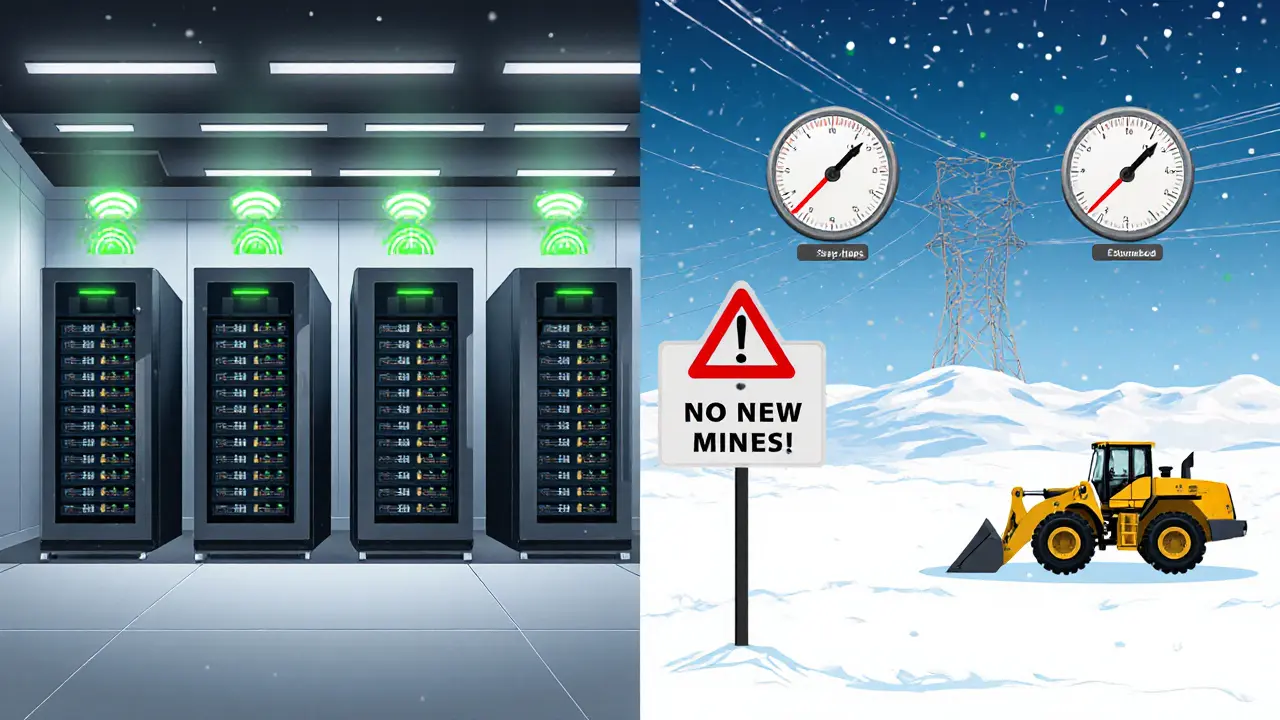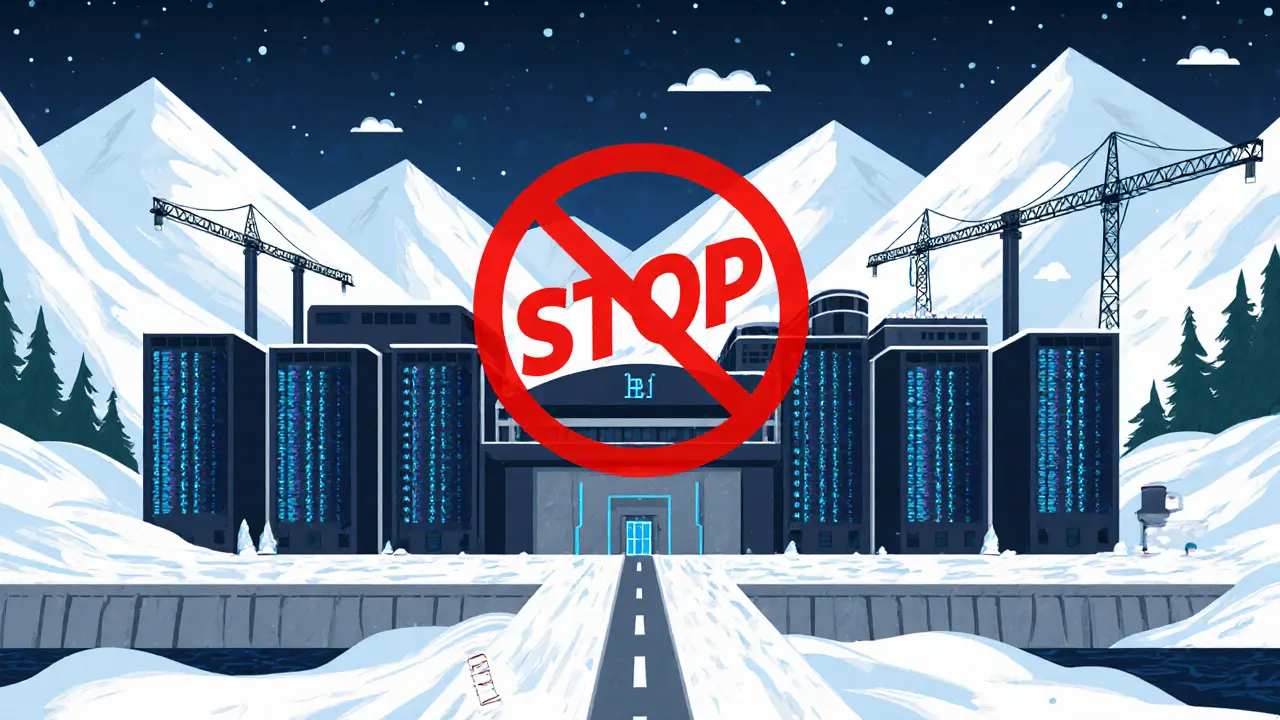By autumn 2025, Norway became the first country in Europe to put a hard stop on new cryptocurrency mining data centers - not because it lacks power, but because it’s choosing where to use it. The country has more renewable electricity than it knows what to do with, mostly from hydropower. But instead of letting crypto firms build massive data centers to mine Bitcoin and other coins, the government said: no new ones. And if you’re already running one? You’re stuck with it - for now.
Why Norway Is Shutting the Door on New Crypto Mines
Norway doesn’t have a shortage of electricity. In fact, over 95% of its power comes from renewable sources, mostly water-driven turbines. For years, that made it a magnet for crypto miners looking for cheap, clean energy. Companies from the U.S., Russia, and China set up operations in places like Tromsø and Sør-Trøndelag, drawn by low rates and cool climates that cut cooling costs. But by 2024, the government started asking: Is this the best use of our power? The answer was no. Minister Karianne Tung of the Ministry of Digitalization and Public Administration put it bluntly: crypto mining is "very power-intensive and generates little in the way of jobs and income for the local community." Compare that to a steel plant, a data center for public health systems, or a hydrogen production facility - all of which create skilled jobs, support local supply chains, and contribute to Norway’s long-term industrial strategy. Crypto mining? It’s mostly automated, needs few workers, and exports value overseas. The electricity used to mine one Bitcoin could power a Norwegian home for over a year. The government decided that energy should go to things that build the country, not just digital ledgers.The Two-Part Rule: Register or Get Banned
Norway didn’t just slap on a ban. It built a system to track and control every data center that touches crypto mining. The rules came into effect on January 1, 2025, under the Norwegian Electronic Communications Act. There are two parts:- Registration is mandatory - all existing data centers had until July 1, 2025, to register with the Norwegian Communications Authority (Nkom). New ones can’t even break ground without approval.
- Temporary ban on new crypto mining facilities - starting autumn 2025, no new data centers can be built if they’re primarily used for cryptocurrency mining.
- Your company name, legal status, and physical address
- Name and contact info of your official representative in Norway
- Full list of customers - including whether they’re public agencies, banks, or crypto mining firms
- Detailed description of services offered - you can’t hide mining behind "cloud hosting" anymore
Existing Mines Are Still Running - For Now
This isn’t China’s 2021 total ban. Norway didn’t flip a switch and shut everything down. It’s a targeted freeze. If you had a mine up and running before autumn 2025, you can keep going. No one’s pulling your servers. But you can’t expand. No new racks. No extra power contracts. No upgrading to more energy-hungry ASICs. That’s created a weird situation: some operators are quietly adding more machines under the radar, hoping they won’t be caught. Others are installing power meters they don’t report, trying to stay under the threshold. But with Nkom now monitoring energy use across the grid, it’s getting harder to hide. The real problem? No one knows the exact power limit that triggers the ban. Is it 5 MW? 10 MW? 20 MW? The government hasn’t published a number. That uncertainty is causing headaches. A company might invest $10 million in a facility, only to find out later it’s classified as "too intensive" and gets blocked. Legal teams are scrambling to interpret vague guidelines.
How This Compares to Other Countries
Norway’s move is a sharp break from its Nordic neighbors. Iceland still welcomes miners. Sweden has tax breaks for green data centers. Finland is building crypto-friendly zones near its nuclear plants. All of them see crypto mining as a way to monetize excess renewable energy. Norway says: Not here. The difference isn’t just policy - it’s philosophy. Other countries treat crypto as an economic opportunity. Norway treats it as a risk to its energy priorities. This isn’t about being anti-technology. It’s about saying: Our clean power is a national asset, not a free commodity for offshore investors. Even the EU’s Markets in Crypto Assets (MiCA) regulation, rolling out in 2025, doesn’t go this far. MiCA focuses on financial reporting, consumer protection, and anti-money laundering - not energy use. Norway is doing something no other EU-aligned country has: tying digital asset activity directly to national energy policy.Who’s Getting Hurt - and Who’s Winning
The impact is uneven. Small-scale miners and local startups are hit hardest. They don’t have legal teams or deep pockets to handle registration costs, compliance paperwork, or the risk of sudden enforcement. Many are shutting down or moving out. Reddit threads from Norwegian mining communities are full of frustration: "I spent $30k on equipment. Now I can’t even get a power upgrade. What do I do?" Big mining firms? They’re relocating. Reports show companies are shifting planned investments to Finland, Canada (especially Quebec and Manitoba), and Georgia - places with stable renewables, low taxes, and no registration traps. On the other side, environmental groups and energy analysts are applauding Norway. They see this as a model. If a country with 95% clean power can say no to energy-wasting tech, then others should too. The World Resources Institute cited Norway’s move as a "critical test case for sustainable digital infrastructure."What Comes Next?
The autumn 2025 ban is just the start. Government officials have hinted that this could expand. What if they start auditing existing mines? What if they cap total energy use for crypto operations? What if they require miners to pay a "renewable energy surcharge"? The Norwegian Financial Supervisory Authority (FSA) is already preparing rules under MiCA. That means crypto mining firms will soon face financial reporting requirements - on top of energy restrictions. Two sets of regulators. Two sets of paperwork. Two ways to get fined. For operators, the message is clear: if you’re thinking about setting up shop in Norway, don’t. The window is closed. For the rest of the world, Norway’s experiment is being watched closely. If this works - if energy use drops without harming the economy - other countries may follow. If it backfires - if miners flee and local jobs don’t grow - Norway could become a cautionary tale. Right now, it’s too early to say which. But one thing’s certain: Norway has drawn a line. And it’s not moving.
What This Means for Crypto Miners
If you’re a miner:- Don’t plan a new facility in Norway. It’s blocked.
- If you’re already there, keep your registration updated. Missing a deadline could cost you millions.
- Track your power use. Even if the threshold isn’t public, going over 5 MW is risky.
- Prepare for more rules. Financial reporting, energy taxes, and audits are coming.
- Start looking at alternatives. Finland, Canada, and parts of the U.S. Midwest are now the new hotspots for green crypto mining.
What This Means for Investors
If you’re investing in crypto infrastructure:- Don’t assume renewable energy = crypto-friendly. Norway proves that’s not true.
- Look for jurisdictions with stable, long-term policies - not just cheap power.
- Consider regulatory risk as part of your due diligence. Norway’s rules changed fast. Others might too.
- Companies that can adapt to strict energy rules may outlast those that can’t.
What This Means for Everyone Else
This isn’t just about crypto. It’s about how societies decide what technology deserves their resources. We’re entering an era where clean energy isn’t unlimited. Every watt counts. Norway is saying: we won’t waste ours on speculative digital gold. Other countries will face the same choice soon. Will they follow Norway? Or will they let the mining rush continue? The answer will shape the future of both energy and digital currencies.Can I still mine crypto in Norway if I already have a data center?
Yes, but only if your facility was operating before autumn 2025. You can keep running it, but you can’t expand it. No new servers, no additional power contracts, and no upgrades that increase energy use. You must also be registered with the Norwegian Communications Authority (Nkom) and keep your records updated. Failure to comply can result in fines up to 5% of your annual turnover.
Why did Norway ban new crypto mining data centers but not existing ones?
Norway chose a "freeze, not a flush" approach. Existing mines were grandfathered in to avoid legal and economic disruption - many were built with government permission before the rules changed. But allowing new ones would lock the country into long-term energy commitments that don’t align with its goals. The goal is to stop growth, not punish past activity. This gives the government time to evaluate whether even existing operations should be capped next.
What’s the energy threshold for the ban? Is there a specific number?
No, the Norwegian government has not published a specific power threshold (like 10 MW or 20 MW) for what qualifies as a "power-intensive" mining operation. This lack of clarity creates uncertainty for operators trying to plan new facilities. Some experts estimate the limit is likely between 5 MW and 15 MW, but until the government releases official guidelines, it’s a legal gray zone. Operators are advised to assume any facility above 5 MW could be flagged.
Can I use my data center for other services besides crypto mining?
Yes - but only if you’re honest about it. The registration system requires you to list all your customers and services. If you’re hosting a crypto mining operation, even alongside web hosting or cloud services, you must declare it. The government is specifically targeting facilities where crypto mining is a primary or significant use. If you try to hide mining under "general cloud hosting," you risk penalties for misrepresentation. Transparency is mandatory.
Where are crypto miners going now that Norway is closed?
Many are relocating to other countries with abundant renewable energy and fewer restrictions. Finland, especially near the Swedish border, is seeing a surge in new data center investments. Canada - particularly Quebec and Manitoba - is another top destination, thanks to low hydroelectric rates and stable policies. Some are also moving to Georgia, Iceland, and parts of the U.S. Midwest like Iowa and Washington, where utilities offer favorable rates and no registration mandates. The trend is clear: miners are fleeing regulation, not renewable energy.


1 Responses
So they just said no to crypto mining? Cool. I guess power’s too precious to waste on digital gold.